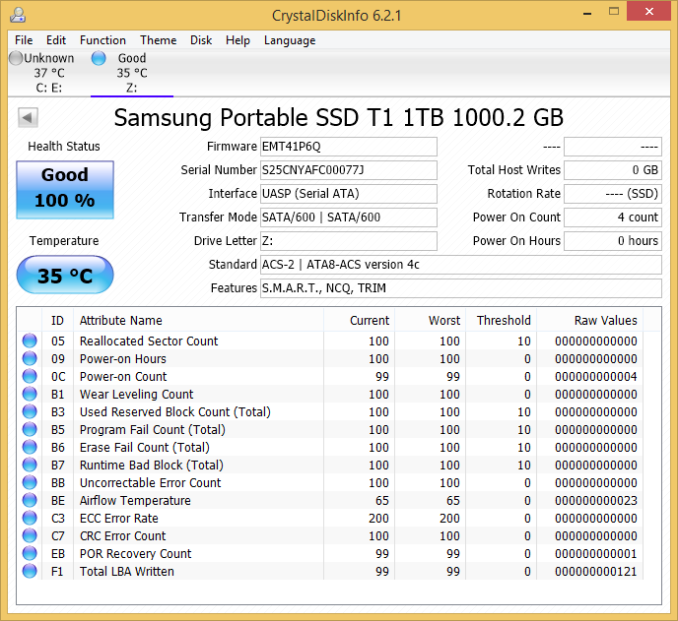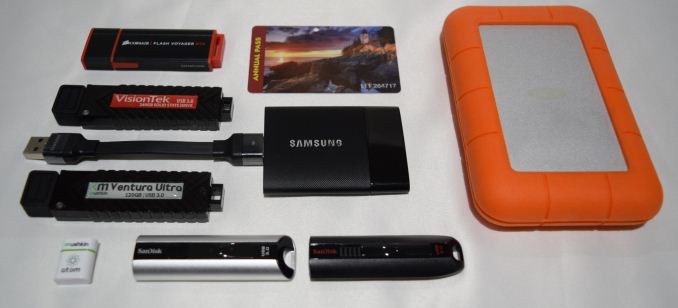Samsung Portable SSD T1 Review
by Ganesh T S on January 20, 2015 10:00 AM EST
Introduction and Testing Methodology
The last few years have seen rapid advancements in flash technology and the rise of USB 3.0 as an ubiquitous high-speed interface on computers. These have led to the appearance of small and affordable direct attached storage units with very high performance for day-to-day data transfer applications. We have already looked at some flash drives with SSD controllers and a USB 3.0 - SATA bridge over the last couple of months. These include the Corsair Flash Voyager GTX 256GB using the Phison S9 controller and the Mushkin Ventura Ultra using the SandForce SF2281 controller respectively.
At CES 2015, Samsung introduced the Portable SSD T1. With the introduction of the T1, Samsung becomes the first tier one manufacturer to enter the external SSD market (if you discount SanDisk's Extreme PRO USB 3.0 flash drives, which, despite being a SSD behind a USB 3.0 - SATA bridge, was never advertised as one). Hardware wise the T1 is based on the 850 EVO, meaning that the T1 uses 32-layer TLC V-NAND and the same full-fledged MEX/MGX SSD controller. CrystalDiskInfo gives us further insight into the unit.
Even though CrystalDiskInfo reports TRIM as a feature, we were unable to get it to work through the bridge configuration. In any case, Samsung also doesn't make any claims about TRIM support. S.M.A.R.T data was not visible to most of the commonly used tools. On the USB 3.0 side, the drive supports UASP (USB-attached SCSI Protocol) that should provide increased performance for sequential transfers. Claimed transfer rates are 450 MBps for sequential accesses and 8K read IOPS / 21K write IOPS. We also have hardware-accelerated AES-256 encryption.
Our review unit was pre-formatted in exFAT. Upon connecting to our testbed, a 128 MB FAT32 partition popped up and provided directions for installing the software / service that allows for the drive to be monitored / utilized with encryption capabilities. After installation, the 128 MB partition disappeared, and the 1 TB volume was made visible. The Samsung SSD program / daemon continues to run in the background and allows for altering the security option (encryption) without reformatting the partition. The gallery below shows the UI of the software running on Windows 8.1 Pro.
Testbed Setup and Testing Methodology
Evaluation of DAS units on Windows is done with the testbed outlined in the table below. For devices with USB 3.0 connections (such as the Samsung Portable SSD T1 that we are considering today), we utilize the USB 3.0 port directly hanging off the PCH.
| AnandTech DAS Testbed Configuration | |
| Motherboard | Asus Z97-PRO Wi-Fi ac ATX |
| CPU | Intel Core i7-4790 |
| Memory | Corsair Vengeance Pro CMY32GX3M4A2133C11 32 GB (4x 8GB) DDR3-2133 @ 11-11-11-27 |
| OS Drive | Seagate 600 Pro 400 GB |
| Optical Drive | Asus BW-16D1HT 16x Blu-ray Write (w/ M-Disc Support) |
| Add-on Card | Asus Thunderbolt EX II |
| Chassis | Corsair Air 540 |
| PSU | Corsair AX760i 760 W |
| OS | Windows 8.1 Pro |
| Thanks to Asus and Corsair for the build components | |
The full details of the reasoning behind choosing the above build components can be found here.
Samsung Portable SSD T1 - Size Comparison (standard credit card size also pictured for a frame of reference)
The list of DAS units used for comparison purposes is provided below.
- Samsung Portable SSD T1 1TB
- Corsair Voyager GTX 256GB
- LaCie Rugged Thunderbolt 500GB
- Mushkin Atom 64GB
- Mushkin Ventura Ultra 120GB
- SanDisk Extreme 64GB
- SanDisk Extreme PRO 128GB
- VisionTek Pocket SSD 240GB


















68 Comments
View All Comments
galfert - Tuesday, January 20, 2015 - link
No TRIM....then no thanks. I'll keep my Corsair Voyager GTX for now.tipoo - Tuesday, January 20, 2015 - link
Do any drives do TRIM over USB 3?tipoo - Tuesday, January 20, 2015 - link
Ah, there it is, there's at least one device that does but most don't.Wwhat - Sunday, February 8, 2015 - link
Since internally it's just a slotted SSD module you could theoretically open the case, unplug it and stick it in your computer and trim it then.Samus - Tuesday, January 20, 2015 - link
The thing is...the write performance of the Voyager GTX is so poor in comparison to the Samsung T1, that even with TRIM support, it's slower at peak (after TRIM) than the Samsung is at its lowest point of consistency. Factor in the Voyager doesn't come in 1TB configuration and costs more per GB, you'd be crazy to buy the Voyager GTX over this.akdj - Tuesday, January 20, 2015 - link
I'm with ya Samus. Samsung is 'well' into it's design and reliability when it comes to flash, NAND, PCIe and SSD storage solutions. You'll be looking at a dime a GB by the time your T1 begins to bum out (due to lack of TRIM/S.M.A.R.T support over USB). Unless you're 'truly' using After Effects or manipulating massive RAW PS files and layers all day, every day I'm not sure it's even a concern anymore. Especially in the consumer segment.Servers and enterprise with massive user volume this may not be the perfect choice. For most, wow. A TB with these speeds and performance/heat & (lack of) throttling IMHO is a Home Run!
I've been using a 2012 15" rMBP daily, since launch with a 768GB, pre PCIe SSD. It's (still) mind numbingly quick using it's internal and external Lacie TBolt SSD. Not a single issue with the laptop or external 500GB SSD after 30 months and ten, respectively. Never a glitch
I'm sold. Will Thunderbolt allow for TRIM support?
Has Samsung built anything with Thunderbolt connectivity yet?
Thanks for the review.
J
Kutark - Tuesday, January 20, 2015 - link
In my limited knowledge, who would really need that type of speed/storage? I'm guessing for most people, even in the IT field, a 64gb or 128gb high speed USB drive is going to be more than fast enough / sufficient space. The only place i could see this being of high need would be professional photographers? I'm sure there's probably some situations out there i'm not aware of, so please correct me if i'm wrong.Basically what i'm saying is for a person who has capacity needs, a regular portable is going to be massively cheaper. For a person who has speed needs, most of the high speed USB drives are very cost effective and have good speeds vs cost. So, i'm wondering how big of a subset of people need both a lot of capacity AND a lot of speed that can justify the cost of this beast.
Laststop311 - Wednesday, January 21, 2015 - link
Not just photographers. If you are a video editor and want to have portability of your raw files on a drive 1TB should be enough space for a fairly long video and if they edit insane amounts of video they can easily buy more of them. This read transfer speed is super important for a video editor to save a ton of time transferring huge 500GB files. Also there really isn't much other choice for 1TB of space and raw uncompressed HD video needs a huge amount of space and because it's so large every drop of speed they can get the need.tipoo - Friday, January 30, 2015 - link
I sometimes have to use multiple VMs off a single external drive, SSD speeds (even across USB 3) would be a godsend for that.designerfx - Tuesday, January 20, 2015 - link
Not just that, but guaranteed heatdeath with time. Most consumer electronics aside from obvious exceptions are not built for operations at 75c, and their throttling simply confirms it. Adding vents to the "portable ssd" won't fix the fact that it's being put in an enclosure.